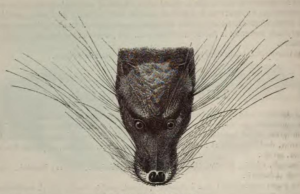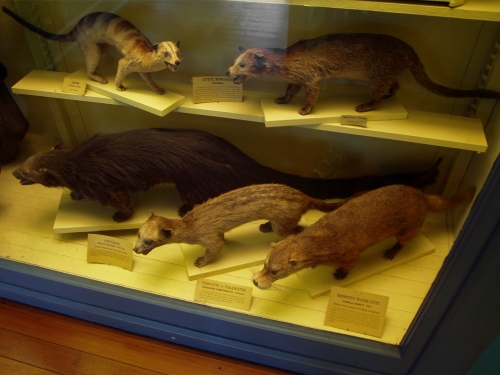I’d bet that most casual observers of Harbor Seals (Phoca vitulina) are under the impression that the little pinnipeds are almost neckless. Of course, it’s not immediately obvious what the skeletal proportions are underneath that blubber, but judging by the forelimb origin, it would seem the neck is less than half the length of the head. Harbor Seals are hiding more neck than what they let on, as their cervical vertebrae are actually similar in length to the skull:
Clearly the live animal above was not holding its neck in the same posture as this skeleton, and (not having X-Ray specs) I’d assume it was similar to the deep “S” curve in this Harp Seal. As for why seals would shorten their apparent necks so dramatically, King (1983) suggested phocids (“true” seals) require a spindle-like shape when swimming since their propulsion comes from oscillating the posterior end of their body. But why bother having a neck at all? A strongly retracted neck gives seals “slingshot potential” to capture prey (Rommel & Reynolds 2002), as alarmingly demonstrated by this Leopard Seal. It’s surprisingly difficult to find photographs of Harbor Seals showing off their full neck — presumably they only do it rarely and briefly — but blogger Kitty Kono has an amazing snapshot:

From Kitty Kono’s blog Back in the U.S.A. Used with permission.
I of course covered all this in my Weddell’s Long-Necked Seal article, but now, I’ll take things further by determining just how long seal necks are. The tails and sacral vertebrae varied much more than what I expected (plus one source often lumped the two), so rather than measure necks relative to the length of the entire spine, I did so relative to only the thoracic and lumbar vertebrae (T–L from here on). And yes, there is going to be an appendix to this blog post.

Black = Skull (gray for no data); Red = Cervical, light blue background equal to shortest neck, pink equal to longest neck; Blue = Thoracic; Green = Lumbar; Yellow = Sacral; Orange = Caudal.
Species are (top to bottom): Dog, Bearded Seal (Erignathus), Weddell Seal (Leptonychotes), Southern Elephant Seal (Mirounga leonina), Leopard Seal (Hydrurga), Hooded Seal (Cystophora), Harbor Seal (Phoca vitulina), Ringed Seal (Pusa hispida), Harp Seal (Pagophilus).
Phocid necks range from 21% T–L in Bearded Seals to 35% T–L in Harp Seals*, which falls short of dogs with necks 40.5% of their T–L. Weddell seals were initially described as “long-necked”, so it’s amazing to see they’re at the low end of the spectrum with necks only 23% T–L. Contemporary sources almost always describe Leopard Seals as “long necked”, however their necks are only 29% T–L, so perhaps “thin-necked” would be a more apt description. The extinct seal Acrophoca is also typically described as “long-necked”, although judging from this skeletal illustration and mounted specimen, the neck is around 30% T–L. The closest true seals have to long necks come from members of the “tribe” Phocini (Phoca, Pusa, Pagophilus), although I have no idea why that would be the case.
* Piérard (1971) cites a source giving 35% for Harbor Seal T–L, so my figure above is probably a shorter-necked young individual.
As for otariids (“eared seals”) — sometimes described as having “snakelike” necks (e.g. Riedman 1990) — do they truly have long necks, or is this a deception from thin necks held out straight? Otariids require a considerable amount of mass before and after their foreflippers (their source of propulsion) for stability, and so they keep their necks out fairly straight (King 1983). Phocid and otariid necks have been described as “similar” in length (Rommel & Reynolds 2002), although just to be on the safe side, I’ll quantify this as well:

Same deal as before, but now with: Walrus (Odobenus rosmarus), Australian Sealion (Neophoca cinerea), Australian Fur Seal (Arctocephalus pusillus doriferus), California Sealion (Zalophus californianus), Steller’s Sealion (Eumetopias jubatus), Northern Fur Seal (Callorhinus ursinus).
Otariid necks vary little, from 34.5% T–L in Australian Sealions (and most other being only slightly higher) to 41% T–L in Northern Fur Seals. So there is certainly quite a pronounced difference in neck length between Bearded Seals and Northern Fur Seals, it does not seem that the average phocid, otariid or walrus is not truly that different in neck length. It should be cautioned that proportional neck length can change considerably during maturity, so there is certainly some error in these figures. The Bearded Seal was reportedly an old female (Hayden 1880) so if anything, it may have had a longer neck than average.
One thing I haven’t mentioned so far is that pinnipeds have far longer tails than most observers would expect, ranging from 13.5% T–L in Northern Fur Seals to 41% T–L in Ringed Seals. I really have no idea why this would be the case.
References:
Allen, J. (1880) History of North American Pinnipeds. Available.
King, J. (1983) Seals of the World.
Piérard, J. (1971) Osteology and Myology of the Weddell Seal Leptonychotes weddelli (Lesson, 1826). Available. IN: Burt, W. (editor) Antarctic Pinnipedia.
Riedman, M. (1990) The Pinnipeds: Seals, Sea Lions, and Walruses.
Rommel, S. & Reynolds, J. (2002) Skeletal Anatomy IN: Perrin, W. et al. (eds.) Encyclopedia of Marine Mammals. Relevant Passage.
| Skull | Cerv. | Thor. | Lumb. | Sac. | Caud. | |
| Dog (King) | ? | 17.00% | 24.00% | 18.00% | 4.00% | 37.00% |
| Bearded (Hayden) | 230 | 250 | 800 | 390 | 175 | 350 |
| Weddell (Piérard) | 0 | 274 | 820 | 385 | 150 | 385 |
| S. Elephant (Hayden) | 480 | 570 | 1690 | 670 | 250 | 680 |
| Leopard (King) | ? | 17.00% | 37.00% | 22.00% | 3.00% | 21.00% |
| Hooded (Hayden) | 265 | 275 | 630 | 320 | 190 | 290 |
| Harbor (Hayden) | 220 | 210 | 445 | 216 | 120 | 230 |
| Ringed (Hayden) | 163 | 200 | 410 | 190 | 100 | 245 |
| Harp (King) | ? | 19.00% | 37.00% | 17.00% | 7.00% | 21.00% |
| Walrus | 390 | 400 | 1170 | 380 | ? | 550 |
| N. Fur (Hayden) | 275 | 430 | 770 | 270 | 160 | 140 |
| N. Fur (Hayden) | 245 | 360 | 680 | 245 | 145 | 145 |
| N. Fur (Hayden) | 200 | 200 | 520 | 185 | 105 | 160 |
| N. Fur (Hayden) | 185 | 172 | 470 | 173 | 95 | 120 |
| Aus. Sealion (King) | ? | 20.00% | 43.00% | 15.00% | 7.00% | 15.00% |
| Aus. Fur (King) | ? | 21.00% | 44.00% | 15.00% | 6.00% | 13.00% |
| Cal. Sealion (Hayden) | 236 | 320 | 640 | 230 | ? | 280 |
| Steller’s (Hayden) | 374 | 500 | 1050 | 340 | ? | 440 |
| Steller’s (Hayden) | 385 | 540 | 1090 | 400 | ? | 520 |
Data from King (1983) were in percentage of the entire spine with no data on skull length. Some Data from Hayden (1880) is in millimeters, and for instances where sacral and caudal vertebrae were lumped, I signified this with “?” in the area for sacral measurement.







